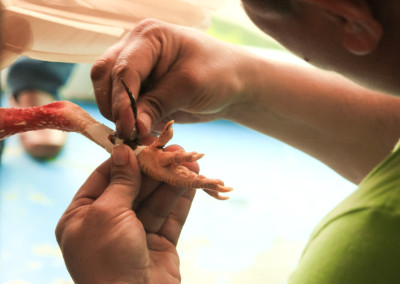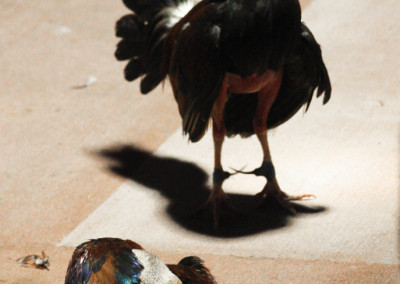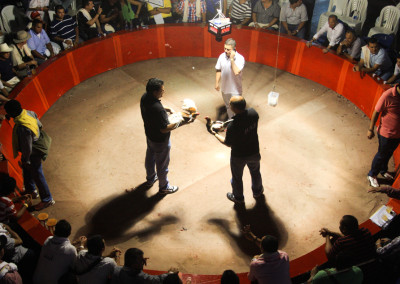Gallos. Nicolas Espinel (Español)
El aleteo de los dos adversarios ahoga los gritos de los apostadores, el ruedo se llena degotas de sangre que marcan los rastros de la pelea y van elaborando un mapa, una gramática violenta que queda como testigo del enfrentamiento. Para aquellos que no estamos acostumbrados una sensación de desespero trepa por las tripas y se va asentando en la boca, es la inmediata certidumbre del desenlace: un buen gallo, un animal de casta, pelea hasta la muerte, no huye, enfrenta, resiste los embates, los picotazos y los golpes de las espuelas que se entierran en la carne blanda. Eriza las plumas y con movimientos tan rápidos, que hasta escapan a la mirada escrutadora de una cámara, arrancan ojos y con algo se suerte (¿para quien?), se alojan en las arterias del pescuezo desangrando al vencido.
El aleteo se va callando, los ataques de lado y lado se van espaciando, el rumor de los galleros retoma su lugar central, estimulando a su gallo, a su socio, tratando de sacar un último aliento de quien por meses fue alimentado, entrenado, querido. Existe una relación ambivalente y contradictoria entre el gallero y sus gallos, una relación atravesada por un acervo cultural que supera la dialéctica moralista del defensor de los animales y la simple noción de la apuesta por puras razones económicas. El gallo es un símbolo de masculinidad con el cual el gallero se identifica. Allí deposita y exalta propiedades culturales como la virilidad, la valentía, el no miedo a la muerte y la lucha hasta al final de los buenos guerreros. Hay una sociedad de amigos, por supuesto significada desde el gallero.
La pelea es una experiencia estética y ritual en donde se hace posible la existencia y despliegue de estos valores masculinos, una puesta en escena en donde los gallos se vuelven una extensión de su dueño. No es de extrañar que la presencia femenina sea reducida, y que en países de gran tradición como Colombia, Venezuela o Puerto Rico hasta ahora se empiezan a visibilizar mujeres apostando y criando gallos. Culturalmente – y estamos hablando de una práctica de largo aliento que se extiende hasta los egipcios y acompaña las tradiciones de lugares tan distantes como Cuba o Bali- el deporte del pico y la espuela ha sido depositario y fuente de la hombría: el gallo era la esperanza del coronel de poder cumplir con sus funciones dentro de la familiar en la conocida obra de Gabriel García Márquez. Era, de un modo metafórico, la hombría perdida.
Finalmente el vencedor picotea al vencido, que se pliega y guarda entre sus alas a esperar la muerte. Mareados y borrachos con la sangre que tiñe el cuerpo los dos animales son retirados del ruedo y las manos empiezan a intercambiar fajos de billetes. Las apuestas de las peleas de gallos, como Clifford Geertz, célebre etnógrafo del siglo pasado nos hace ver, van más allá del simple intercambio de dinero. Apostar es una cuestión de honor y conocimiento, es también una muestra de conocimiento pero, más importante aún, es comportarse de la misma forma honorable que se le pide al gallo: la resolución, la seguridad, la valentía y el honor con que se enfrenta la pérdida y la gallardía con que se asume la ganancia.
En las apuestas de gallos existen dos niveles de apuesta, las que suceden entre los dueños de los gallos y las que suceden entre el resto de los asistentes. Las primeras determinan la calidad de la pelea, el monto de la apuesta es una muestra de la confianza que tienen los dueños por sus gallos y es prenda de garantía para el resto de los apostadores. Tanto en la una como en la otra las apuestas se realizan verbalmente, sin estar mediadas por recibos o papeles de garantía. No hay documento que testifique porque la valides esta dada por la palabra que empeña el apostador, por esto se le considera a la gallistica un deporte de caballeros.
En las últimas décadas la tradición del “deporte” de los gallos ha ganado visibilidad gracias al emergente discurso del maltrato animal. Adeptos y opositores defienden sus respectivas trincheras utilizando argumentos siempre conflictivos: la tradición y el patrimonio cultural por un lado y por otro el abuso, la defensa de la vida y la puesta en escena de teatros en donde se glorifica la violencia y exacerba una visión dominante del mundo. En Puerto Rico se ha cuestionado la viabilidad de mantener las peleas dentro del marco legal al cuestionar los tipos de practicas que debe tener una sociedad “civilizada”.
En Colombia, donde ha surgido un solido movimiento de defensa y promoción de los derechos de los animales, también se propuso este año una ley para convertir las peleas de gallos en patrimonio inmaterial de la cultural del país.
Mas allá de tomar una posición es interesante ver la forma en como las pelas de gallos se constituyen no solo como vehículos sino como forma de posibilidad de ciertos contenidos culturales. Son, consecuentemente, un lugar de disputa en donde la identidad es formulada y reformulada: la relación con (el resto de) los animales, con el yo animal y racional que se significa desde diferentes puntos de vista, con la vida y la muerte, que toman forma desde la idealización de determinados rasgos, como se debe vivir, como se debe morir. No podemos olvidar la materialidad del asunto, las peleas de gallos son unmucrativo negocio que mueve cantidades significativas de dinero en flujos organizados alrededor de pequeñas y fugaces redes económicas locales que se esconden y al mismo tiempo hacen parte del mundo globalizado.
Los gallos son eso y mucho mas: vehículos, representaciones, instrumentos, lienzos en donde se visibiliza la intrincada y compleja relación del ser humano consigo mismo, con sus pares, con el mundo. Las disputas que se generan alrededor de esta practica no hacen mas que reforzar la idea de la importancia que tienen estas practicas dentro de determinados contextos culturales. Pero mas allá de esto, o quizá por esto mismo, tenemos al gallo y al hombre en el centro del ruedo, la sangre que se riega, el seco aleteo, las espuelas que se alojan en la piel del otro, el gallero dando un ultimo beso de despedida al animal moribundo.
Nicolas Espinel
Gallos. Nicolas Espinel English)
Gallos
The fluttering of adversarial wings drowns the bettors’ cries; blood drops that fill the cockpit trace evidence of a fight, and draw a map of a violent articulation which remains as testament to a confrontation. For those not accustomed, a feeling of despair grows from the gut and settles in the mouth; it is the sudden certainty of the outcome: a good fighting rooster, a purebred fights till death, does not flee, rather confronts, endures the attack, the pecks, the spur beating that digs into the soft flesh. Feathers stand on end, and with fast moves that slip by the camera’s scrutiny, eyes are gouged out and with a bit of luck (for whom?) these land on neck arteries bleeding the defeated dry
The flutter begins to subdue; the attacks from both sides become less frequent. The gallero’s murmuring comes into focus, as he attempts to enliven his rooster, his partner, the gamecock, who for months he’s fed, trained, loved and from whom he now attempts to pull one last breath. The gallero-gamecock affair is an ambivalent and contradictory one. Their relationship comes from a cultural heritage that defies the animal advocate’s moralistic dialectic and the gambler’s simple notion of betting for purely monetary reasons. Thegallero identifies himself with his fighting rooster– a symbol of masculinity. Here, he places and extols cultural values such as virility, courage, fearlessness in the face of death and like all good warriors, the commitment to fight until the very end. Of course, it is the gallero’s understanding, that there’s also a partnership between friends.
The cockfight is an aesthetic experience; a ritual in which these masculine values are displayed, staged, and where the fighting rooster becomes an extension of its owner. It is no wonder the female presence has been smaller, and not until today, do we see women starting to bet and breed gamecock in countries with a long tradition, such as Colombia, Venezuela and Puerto Rico. Culturally, we are talking about a long-term practice that includes Ancient Egypt and reaches traditions from distant places, like Cuba or Bali-This sport of ‘beak and spur’ [del pico y la espuela] has been the keeper and source of manhood: in Gabriel García Márquez’s famous work, No One Writes to the Colonel, the fighting rooster, upon whom the Colonel bestows all his hope of fulfilling his family role becomes a metaphor for lost manhood.
Finally the victor pecks the vanquished, that folds and protects itself with its wings
only to face death. Dizzy and drunk, the two blood stained animals are removed from the pit while hands begin exchanging wads of cash. As famous 20th century ethnographer, Clifford Geertz once stated, cockfight betting goes beyond a simple exchange of money. Betting is a matter of honor, a show of knowledge but, most importantly, an opportunity to demonstrate the honorable composure that is expected from the fighting rooster: resoluteness, confidence, courage and honor as it confronts loss; and poise when taking the winnings.
Cockfighting bets takes place on two levels, amongst the owners themselves and with the rest of the attending public. The former determines the quality of the fight, and the bet amount is a sign of the owners’ confidence in their rooster and a pledged collateral to the rest of the bettors. On both levels, the bets are made verbally, not involving receipts nor warranty papers. Since the bettor’s given word is what determines its validity; no document is necessary to attest the bet. For this reason cockfighting is considered a gentleman’s sport.
In recent decades, the tradition of the cockfighting “sport” has gained visibility thanks to the growing discourse on animal cruelty. Supporters and opponents defend their respective trenches using always clashing arguments: on the one hand, tradition and cultural heritage, on the other, abuse, and the defense of life, staging a theatre production in which violence is glorified and a dominant view of the world is heightened. When questioning the types of legal practices a “civilized” society should have, Puerto Rico has challenged the existence of cockfights. This year, Colombia, where a strong movement in defense and promotion of animal rights has emerged, has also proposed a law to consider cockfighting as part of the country’s intangible cultural heritage.
Beyond taking a stand, it is interesting to see the way cockfighting has become not only the means, but rather some form of possibility for cultural content. As a result, it remains a point of contention, where identity is formulated and reformulated: its relationship with (the rest of) the animals, with the rational animal “self” able to signify itself from multiple perspectives, in respect to life and death, that takes shape based on the idealization of certain traits, how one should live, how one must die. We can not forget the materiality of the matter; cockfighting is a lucrative business that handles the flow of significant amounts of money in organized systems involving small and fleeting local economic networks, which at times hide, yet
also are part of a globalized world.
The fighting rooster is this and much more: a medium, a symbol, a tool, a canvas on which man’s intricate and complex relationship to himself, with his peers, with the world, is made visible. The arguments brought about by this practice only emphasize the importance of such practices within specific cultural contexts. But beyond this, or perhaps due to this, we have at the center of the ring a fighting rooster and man, spilt blood, a sharp flutter, spurs dwelling on the other’s skin, and a gallero giving a farewell kiss to a dying animal.
By Nicolas Espinel
Translated by: Angeles Romero























